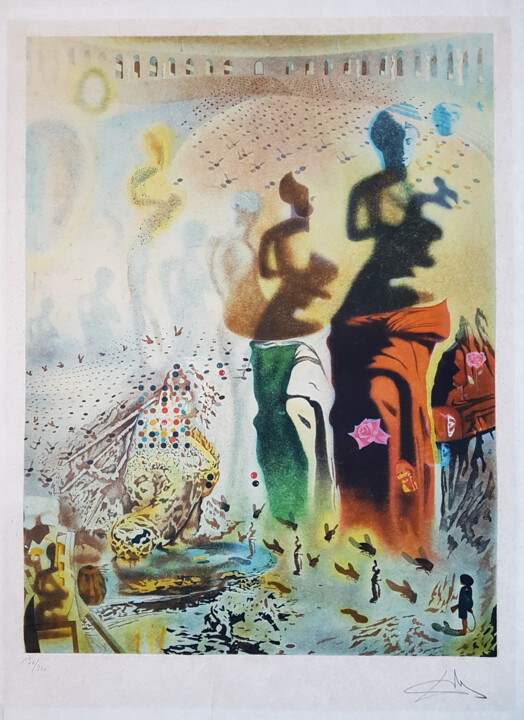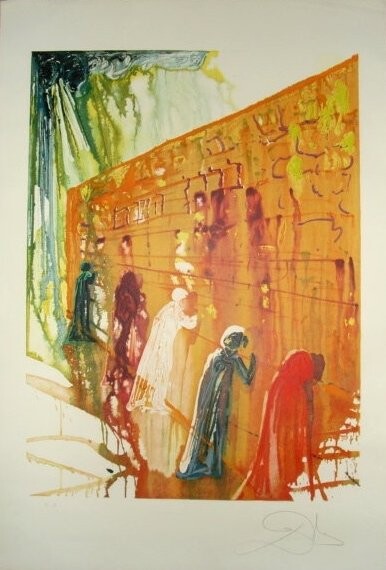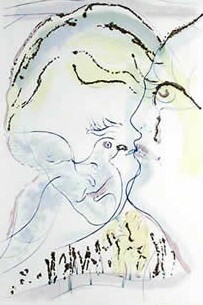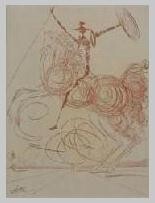Salvador Dalí (1904-1989), a renowned Spanish surrealist artist, was celebrated for his technical skill, precise draftsmanship, and strikingly bizarre imagery. Born in Figueres, Catalonia, he studied fine arts in Madrid, initially influenced by Impressionism and Renaissance masters before embracing Cubism and Surrealism. Dalí joined the Surrealist group in 1929, creating iconic works like The Persistence of Memory. He lived in France during the Spanish Civil War and later moved to the U.S. in 1940, achieving commercial success before returning to Spain in 1948. Dalí's diverse artistic repertoire spanned painting, sculpture, film, and more, alongside his notorious eccentricity. Despite controversy over his support for Franco and commercialism, his influence on Surrealism, pop art, and contemporary art remains profound. Major museums in Spain and the U.S., dedicated to his legacy, attest to his lasting impact.
Artist Biography
Salvador Dalí, born on May 11, 1904, in Figueres, Catalonia, Spain, is a towering figure in the surrealist movement. Raised under the influence of his strict lawyer father, Salvador Luca Rafael Aniceto Dalí Cusí, and his nurturing mother, Felipa Domènech Ferrés, Dalí's childhood combined discipline with artistic freedom. The premature death of his older brother, also named Salvador, deeply affected him, leading to his belief in reincarnation, a theme that permeated his art and writings. Early education at the Municipal Drawing School in Figueres and exposure to modern art in Cadaqués shaped his artistic development. Recognizing his talent, his father organized Dalí's first exhibition at home, and by 1918, he had his public debut at the Municipal Theatre in Figueres. The loss of his mother in 1921 further fueled his artistic expression.
In 1922, Dalí moved to Madrid to study at the Real Academia de Bellas Artes de San Fernando. His eccentric personality and unique style attracted attention, and he formed close relationships with influential figures like Federico García Lorca and Luis Buñuel. Immersed in avant-garde movements like Dada and Futurism, Dalí's early works blended Cubism and Futurism with meticulous draftsmanship. His first solo exhibition in Barcelona in 1925 was a critical success, establishing his reputation. Meeting Pablo Picasso in 1926 deeply influenced Dalí's evolving style. Embracing Surrealism fully by 1929, he collaborated with Buñuel on Un Chien Andalou and produced iconic paintings like The Great Masturbator. That year, he met Gala, who became his muse and wife. However, Dalí's provocative works and lifestyle strained his relationship with his father, leading to being disinherited.
Dalí's fame soared in the early 1930s with works like The Persistence of Memory (1931), featuring melting clocks that became emblematic of Surrealism. Despite his expulsion from the Surrealist group in 1939, he continued to thrive, creating renowned works and cementing his legacy as a controversial artist. During World War II, Dalí and Gala lived in the United States, where he engaged in diverse projects, including film and autobiography. Returning to Spain in 1948, Dalí's support for Franco's regime drew criticism, yet he continued to innovate with themes blending Catholicism and scientific imagery in his "Nuclear Mysticism" phase. Dalí's later years focused on natural science and mathematics, incorporating optical illusions and innovative techniques into his work. He maintained prolific output, collaborated with artists like Andy Warhol, and oversaw the Dalí Theatre-Museum in Figueres, where he is buried following his death on January 23, 1989. Salvador Dalí's legacy endures through his unparalleled creativity and provocative art that continues to captivate audiences worldwide.
Surrealism and Salvador Dalí
Surrealism, an influential movement in visual art and literature, flourished in Europe between World Wars I and II, emerging from the earlier Dada movement. Unlike Dada’s anti-art stance, Surrealism aimed for positive expression by merging conscious and unconscious experiences, a concept championed by André Breton in his 1924 Surrealist Manifesto. Inspired by Sigmund Freud’s theories, Surrealist artists like Salvador Dalí, René Magritte, and Max Ernst sought to explore the unconscious through techniques such as automatic drawing and frottage, often producing dreamlike, irrational imagery. The movement’s diverse artistic expressions ranged from the biomorphic forms of Jean Arp to the meticulously detailed, yet surreal, worlds of Dalí and Magritte. Despite internal conflicts and Breton’s doctrinal demands, Surrealism significantly impacted modern art, providing a counterpoint to Cubism’s formalism and emphasizing content and personal psychic exploration. Surrealism is an art and cultural movement that developed in Europe in the aftermath of World War I, with artists aiming to allow the unconscious mind to express itself, often resulting in the depiction of illogical or dreamlike scenes and ideas. André Breton, the movement's leader, described Surrealism as the resolution of the previously contradictory conditions of dream and reality into an absolute reality, or surreality. It produced works in painting, writing, theatre, filmmaking, photography, and other media. Works of Surrealism feature elements of surprise, unexpected juxtapositions, and non sequitur. Many Surrealist artists and writers regard their work as an expression of the philosophical movement first and foremost, with the works themselves being secondary artifacts of surrealist experimentation. Breton asserted that Surrealism was, above all, a revolutionary movement, often associated with political causes such as communism and anarchism. It was influenced by the Dada movement of the 1910s.
The term "Surrealism" originated with Guillaume Apollinaire in 1917 and was officially established after the publication of Breton's Surrealist Manifesto in October 1924. Paris, France, was the most important center of the movement, which spread around the globe, impacting visual arts, literature, film, music, political thought, philosophy, and social theory. Freud's work with free association, dream analysis, and the unconscious was crucial for the Surrealists. They emphasized combining elements not normally found together to produce illogical and startling effects. Breton's 1924 manifesto included the idea of startling juxtapositions, inspired by a 1918 essay by poet Pierre Reverdy. The Surrealists aimed to revolutionize human experience by freeing people from false rationality and restrictive customs.
The movement saw two rival Surrealist factions in 1924, led by Yvan Goll and André Breton. Goll's group included notable figures like Francis Picabia and Robert Delaunay, while Breton's group included Dalí, Louis Aragon, Philippe Soupault, and many others. Breton's group eventually grew larger and became the dominant faction. Dalí joined the Surrealist group in 1929, rapidly establishing a visual style characterized by meticulous detail and dreamlike scenes. His works, such as "The Persistence of Memory," with its melting clocks, became iconic images of Surrealism. Dalí's contribution to the movement was significant, as he helped to popularize the Surrealist visual style through his unique and compelling imagery. Throughout the 1930s, Surrealism became more visible to the public through major exhibitions and the involvement of prominent artists like Dalí and Magritte. Despite the disruptions caused by World War II, many Surrealist artists continued to work and influence the art world. Dalí's work, in particular, continued to evolve, blending surrealist themes with new techniques and ideas. Surrealism's influence persisted long after the movement's peak, with artists like Dorothea Tanning and Louise Bourgeois continuing to explore its themes. Dalí remained a central figure in the movement, his work bridging the gap between Surrealism and later artistic developments.
Artistry of Salvador Dalí
Symbolism: Salvador Dalí's art is steeped in symbolism, often characterized by bizarre and incongruous images that invite interpretative depth. His work from the late 1920s onwards introduced motifs that ranged from Freudian symbolism to deeply personal and idiosyncratic elements. While some symbols, such as melting clocks in The Persistence of Memory, allude to Einstein's theory of relativity and the fluidity of time, others like rotting donkeys and sea urchins remain enigmatic, subject to diverse interpretations. Dalí's fascination with Freudian theory, evident in his readings in the 1920s, influenced much of his early symbolic language, which evolved into a unique visual lexicon over his career.
Food: Food and its sensual connotations play a central role in Dalí's artistic narrative. He intricately wove food into his imagery, seeing it as a metaphor for beauty, desire, and mortality. The recurring motif of bread symbolized continuity and sustenance in his art, from The Basket of Bread to his public performance in Paris with a 12-meter-long baguette. Dalí's fascination extended to the egg, which he imbued with prenatal and intrauterine symbolism, representing hope and fecundity. The thematic use of food in his works underscores his belief in its sacred and foundational role in human existence.
Animals: Dalí's artistic menagerie includes a diverse array of animals, each laden with symbolic import. The rhinoceros, with its spiral horn symbolizing divine geometry, served dual roles in his art: representing chastity and the Virgin Mary while also assuming phallic connotations in works like Young Virgin Auto-Sodomized by the Horns of Her Own Chastity. Dalí's interpretations of animals such as ants, locusts, and elephants were multifaceted, addressing themes of decay, desire, and cultural symbolism. Each creature in Dalí's oeuvre reflects his complex interplay of personal iconography and broader cultural allegories.
Science: Dalí's lifelong fascination with science and mathematics permeated his artistic vision. His famous "soft watches" in The Persistence of Memory are interpreted as visual metaphors for Einstein's theories of time and space, challenging conventional notions of temporality. In response to scientific advancements like atomic theory, Dalí incorporated imagery of atomic particles and DNA into his later works, reflecting the contemporary anxieties and fascinations of his era. His exploration of quantum mechanics in The Disintegration of the Persistence of Memory underscores his engagement with scientific concepts as metaphysical and philosophical inquiries.
Endeavors Outside Painting: Salvador Dalí's artistic versatility extended beyond painting into sculpture, jewelry design, and other interdisciplinary realms. His surreal objects, such as the iconic Lobster Telephone and Mae West Lips Sofa, subverted everyday reality, merging the mundane with the uncanny. Dalí's ventures into jewelry design yielded intricate pieces like The Royal Heart, a testament to his craftsmanship and flair for the fantastical. His forays into industrial design and collaborations with fashion houses like Christian Dior and Elsa Schiaparelli underscore his influence beyond the confines of traditional art forms. Dalí's multidimensional approach to art blurred distinctions between disciplines, exemplifying his avant-garde spirit and enduring impact on artistic expression.
Theater and Film: Dalí's creative output extended into theater and film, where his surrealist aesthetic found fertile ground. Collaborations with figures like Luis Buñuel yielded groundbreaking films such as Un Chien Andalou and L'Age d'Or, which challenged narrative conventions and explored subconscious realms. His theatrical designs for ballets and operas infused performances with surreal visual narratives, embodying his belief in the transformative power of art. Dalí's engagement with film continued through unrealized projects and collaborations with filmmakers like Alfred Hitchcock and Walt Disney, marking his enduring influence on cinematic surrealism and visual storytelling.
Fashion and Photography: In the realms of fashion and photography, Dalí's influence extended through innovative designs and collaborations. His partnership with Elsa Schiaparelli produced iconic garments and accessories, including the Lobster Dress and Shoe Hat, which blurred boundaries between fashion and art. Dalí's photographic collaborations with luminaries like Philippe Halsman captured his playful yet enigmatic persona, reflected in series like Dalí Atomicus. His architectural endeavors, including the Dalí Theatre-Museum in Figueres, stand as monumental expressions of his artistic vision, integrating surrealism into physical spaces.
Literary Works and Graphic Arts: Dalí's literary contributions encompassed novels, essays, and poetry, reflecting his intellectual breadth and literary ambitions. His novels, including Hidden Faces, explored themes of decadence and intrigue within aristocratic circles, paralleling his visual explorations of desire and dissonance. In graphic arts, Dalí's mastery extended from intricate etchings and lithographs to iconic illustrations for works like The Divine Comedy, showcasing his skill in merging visual art with narrative storytelling. His collaborations with authors and poets underscored his interdisciplinary approach, bridging literature with surrealism's visual lexicon.
Les Songes Drolatiques de Pantagruel (1973) by Salvador Dalí
Salvador Dalí, Les Songes Drolatiques de Pantagruel, 1973. Printmaking, Lithography on Paper, 76cm x 54cm.
The set of four lithographs by Salvador Dalí from 1973, titled Les Songes Drolatiques de Pantagruel, showcases the artist's mastery of surrealism and his penchant for exploring the depths of human psyche through art. These prints, created using lithography on Japanese paper, are part of Dalí's interpretation of François Rabelais' 16th-century novels chronicling the fantastical adventures of giants Gargantua and Pantagruel. Known for his adoption of the "paranoiac-critical method," which melded reality and imagination, Dalí delves into the erotic and surreal aspects of Rabelais' narratives. His prints, infused with grotesque and comical elements, reflect Dalí's fearless approach to subject matter, finding both sophistication and humor in the bizarre. By intertwining Freudian and Krafft-Ebing influences with his own surrealist vision, Dalí transforms these lithographs into vivid visual tales that challenge conventional boundaries of art and storytelling.
Bucéphale (1971) by Salvador Dalí
Salvador Dalí, Bucéphale, 1971. Painting, 25cm x 20cm.
Salvador Dalí's ceramic plate titled Bucéphale, crafted in 1971 and numbered CXCVIII/XD, exemplifies his distinctive surrealist style within the realm of three-dimensional art. Known primarily as a painter, Dalí's foray into ceramics showcases his ability to meld classical influences with avant-garde surrealism. The plate, measuring 25×20 cm (42×38 cm with frame), bears Dalí's signature blend of dreamlike imagery and meticulous craftsmanship. Influenced by his exploration of Freudian theories and the subconscious mind, Dalí's work often delves into themes of time, memory, and the irrational. This piece, accompanied by a Certificate of Authenticity, underscores Dalí's multifaceted talent and his ability to innovate across various artistic mediums, reinforcing his enduring impact on 20th-century art and culture.
Iconic Artworks
Salvador Dalí's iconic artworks showcase his unparalleled ability to blend surrealism with intricate symbolism and vivid imagination. The Persistence of Memory (1931), housed in New York's MoMA, introduces viewers to Dalí's dreamlike world where melting clocks symbolize the relativity of time, inspired by the sight of a melting Camembert cheese. In The Elephants (1948), located in St. Petersburg's Salvador Dalí Museum, gravity-defying elephants with elongated legs dance across the canvas, a whimsical feat of surrealism. The Sacrament of the Last Supper (1955) at Washington D.C.'s National Gallery of Art transforms biblical narratives into a surreal banquet. Christ of Saint John of the Cross (1951), in Glasgow's Kelvingrove Art Gallery, reinterprets the crucifixion with a cosmic perspective. Meanwhile, Galatea of the Spheres (1952) at the Dalí Theatre-Museum in Figueres, Spain, orchestrates a cosmic ballet of spheres. These artworks showcase Dalí's skillful blend of the subconscious and reality.
Exhibition History and Art Market
Salvador Dalí's exhibition history spans from his early solo shows to posthumous retrospectives, highlighting his evolution as a seminal figure in 20th-century art. His career began with a solo exhibition at Galeries Dalmau, Barcelona in November 1925, blending traditional themes with experimental surrealism. In 1979, a landmark retrospective at the Pompidou Centre in Paris drew 850,000 visitors, followed by another successful exhibition there in 2012 with over 760,000 tickets sold. These events celebrated Dalí's surrealistic visions and cultural impact.
In 2013, Madrid's Reina Sofia Museum presented "Dali (All of the poetic suggestions and all of the plastic possibilities)," showcasing over 200 works to highlight Dalí's profound influence on modern art. His global impact extended to China in 2015 with a grand retrospective organized by the Gala-Salvador Dalí Foundation, introducing his surrealistic repertoire to Chinese audiences.
Specialized exhibitions like "Dalí: Painting and Film" at MoMA in 2008 explored his cinematic collaborations, while the 2019 retrospective "Dali, a History of Painting" at the Grimaldi Forum in Monaco traced his artistic evolution through approximately one hundred works. Throughout these exhibitions, Dalí's surrealistic visions and thematic explorations have continued to captivate global audiences, solidifying his legacy as one of the most influential artists of the modern era.
Salvador Dalí's impact on the art market remains significant, with his works fetching substantial prices worldwide. Over the past five years, Dalí's prints have shown steady growth, averaging around £2,872 per piece. However, the Dalí print market faces challenges from widespread forgeries, highlighting the importance of authentication in transactions involving his artworks.
Dalí's auction successes are exemplified by record-breaking sales of his paintings. In February 2011, Portrait De Paul Eluard sold for £13.5 million at Sotheby’s London, marking the highest price ever paid for a Dalí painting. This masterpiece from 1929 reflects Dalí's artistic evolution during his Parisian period and its historical significance. Printemps Necrophilique fetched over £10 million at Sotheby’s New York in May 2012, showcasing Dalí's mature Surrealist style.
In October 2020, Couple With Their Heads Full Of Clouds sold for nearly £8.2 million at Bonhams London, demonstrating Dalí's enduring appeal. The Angelus, reimagining Millet's painting, sold for just under £8 million at Sotheby’s New York in November 2021, highlighting Dalí's unique interpretation of religious themes through Surrealism.Throughout Dalí's auction history, works like Moment Of Transition and Spectre Du Soir Sur La Plage have continued to captivate bidders, reaffirming his legacy as a pioneering Surrealist. These auctions underscore Dalí's ability to challenge artistic norms, making his works coveted assets in the global art market.
Artist Inspired by Salvador Dali
Known for his flamboyant personality, including a meticulously groomed moustache and penchant for eccentric pranks like paying restaurant bills with art sketches on the back of checks, Dalí embraced fame and controversy alike. His influence extended beyond the art world, touching pop culture through collaborations with figures like Andy Warhol and iconic designs such as the Chupa Chups logo. Salvador Dalí's revolutionary approach to Surrealism continues to inspire contemporary artists across various mediums, each interpreting and reimagining his visionary style in unique ways. The following artists not only pay homage to Salvador Dalí's pioneering contributions to Surrealism but also reinterpret his legacy for a modern audience, demonstrating the enduring influence and relevance of Dalí's visionary artistry.
Jeff Koons, renowned for his playful and often monumental sculptures, credits Salvador Dalí as a significant influence on his artistic journey. Introduced to Dalí's work at a young age, Koons was captivated by the Surrealist's ability to blend personal and mass-cultural symbols into cohesive and surreal compositions. This influence is evident in Koons' iconic balloon animal sculptures, which echo Dalí's juxtaposition of seemingly disconnected elements into harmonious visual narratives.
Scottish contemporary artist Ross Muir, known for his versatility across artistic genres, pays homage to Dalí through his reinterpretation of iconic artworks with a modern twist. In his piece Clocks from 2021, Muir transforms Dalí's famous The Persistence of Memory (1931) by replacing melting clocks with contemporary symbols like Gucci sneakers and Rolex watches. This playful approach not only updates Dalí's surrealism for the present day but also celebrates the enduring impact of his artistic legacy.
Joseph Klibansky, like Dalí, creates monumental sculptures that defy traditional artistic norms. His surrealist sculptures often feature animals and astronauts in whimsical scenarios, exuding a sense of wonder and fantasy akin to Dalí's surrealistic visions. Klibansky's expansive studio and collaborative approach echo Dalí's method of realizing grandiose artistic concepts on a monumental scale, underscoring his admiration for Dalí's bold and imaginative spirit.
Salvador Dalí's legacy extends far beyond his artworks, as evidenced by the dedicated museums in Figueres, Spain, and St. Petersburg, Florida, USA, showcasing his prolific career. His influence spans across pop art, Surrealism, and contemporary art movements, impacting renowned artists like Jeff Koons and Damien Hirst. Dalí's cultural imprint is further solidified through cinematic portrayals by actors like Robert Pattinson and Adrien Brody, and the iconic Dalí masks worn in the Spanish television series Money Heist, chosen for their symbolic Spanish imagery. Additionally, geographical features such as the Salvador Dalí Desert in Bolivia and the Dalí crater on Mercury, along with the container ship MV Dali, all bear homage to his enduring cultural significance. The Gala-Salvador Dalí Foundation now oversees his estate, represented in the US by the Artists Rights Society, ensuring his artistic and cultural contributions continue to be celebrated and protected worldwide.
From his early mastery of surrealism to his later explorations in film, theater, and interdisciplinary collaborations, Dalí's career embodies a relentless pursuit of artistic innovation and self-expression. His ability to merge the realms of dream and reality, often through provocative and meticulously crafted imagery, continues to captivate audiences globally. Despite controversies surrounding his political views and commercial pursuits, Dalí's influence on pop art, contemporary surrealism, and popular culture remains profound and enduring. Through institutions like the Dalí Theatre-Museum in Figueres and the Salvador Dalí Museum in St. Petersburg, Dalí's legacy is preserved and celebrated, ensuring that his visionary contributions to art and culture will inspire generations to come.

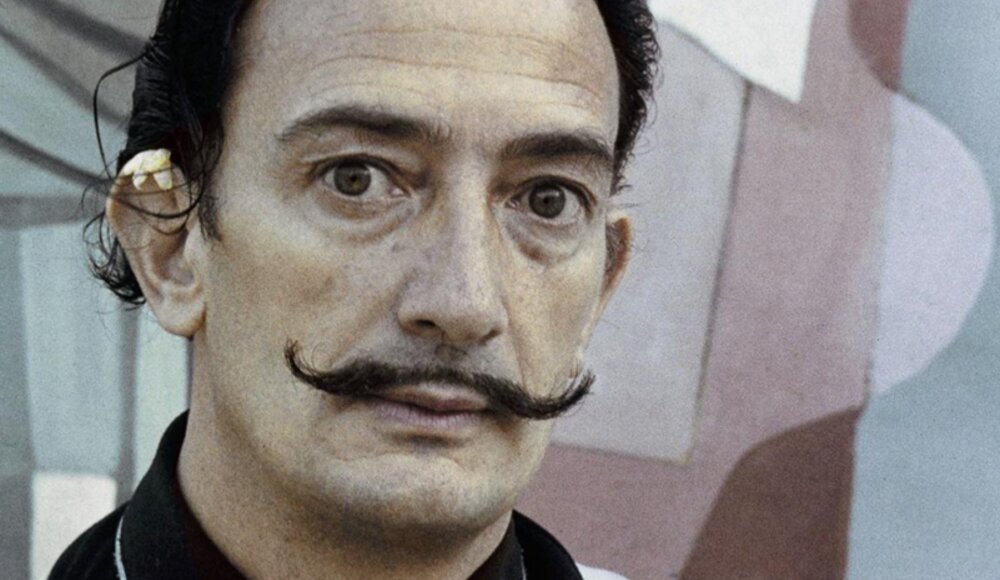


 Selena Mattei
Selena Mattei

